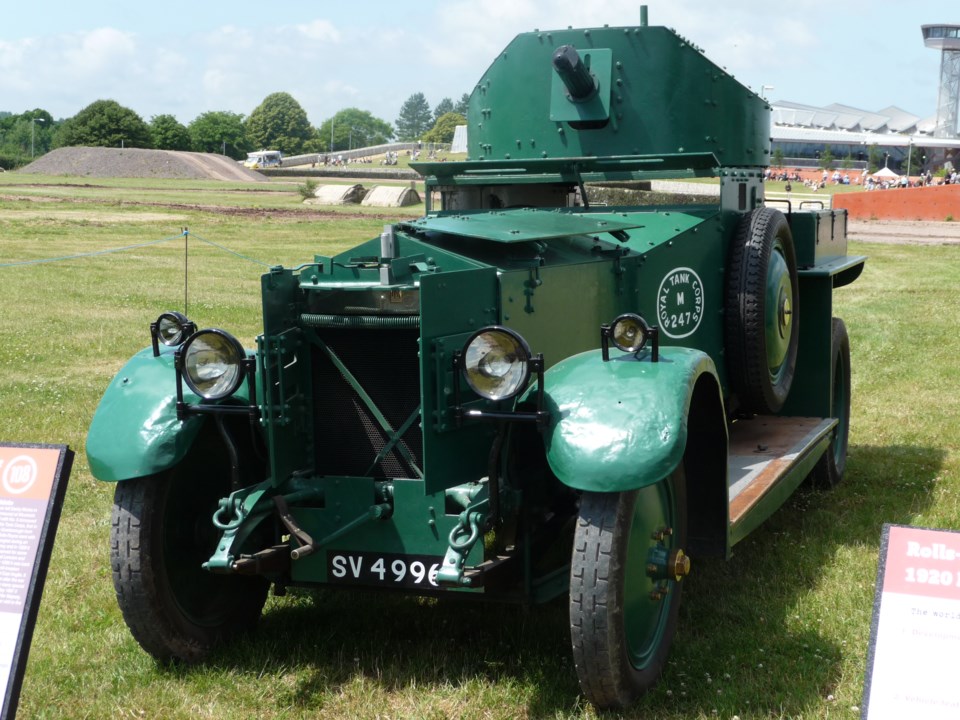In August of 1914, Commander Charles Rumney Samson of the British Navy went to war in a Rolls-Royce. The car, a hastily patched-together open-tourer with makeshift boilerplate armour and a rear-mounted machine gun, engaged a German staff car at range, stitching it up with sustained fire from the Maxim gun.
The enemy was understandably shocked, not knowing what to make of this wheeled monstrosity. They fled, and emboldened by success, Samson took a flying squadron of four vehicles into enemy territory, careening down the streets of Lille. Here, a nervous inhabitant threw a ginger beer bottle at the car and hit Commander Samson in the face.
A slightly ignominious beginning for one of the most unlikely wartime machines ever built, but the somewhat bruised Samson posted flyers throughout town indicating his occupation of Lille.
This action caught the eye of the Admiralty office, and it wasn’t long before proper armoured cars were making their way to the field of battle. Thus, the armoured Rolls-Royce began a long four decades of faithful service.
In the beginning, Rolls-Royce made cars for the wealthy and aristocratic. Many early aviators came from the upper classes, and thus had their personal staff cars brought with them to the forward bases. This being the early days of flight, aircraft were spidery and rickety, and sometimes crashed even if they weren’t being shot at.
Commander Samson, the first man to fly an airplane off a moving vessel, was a pioneer in military aviation, but his brainwave to use the personal motor vehicles of his officers may have been an even greater contribution to the war effort.
Properly armed, these early cars participated in rescue missions, and were also swift on patrol duty, making German reconnaissance (mostly done on horseback) difficult.
The first proper armoured Rolls-Royces were built on the 40/50 Silver Ghost chassis, each one a little different owing to the coach-built process. Spotting via aircraft was used to find the enemy, and then these steel behemoths would strike quickly, carrying troops and laying down fire from their Maxim and Vickers machine guns.
For more than a year, the flying squadrons harassed the enemy, but it was not long until mobile warfare was no longer part of the First World War’s main campaign. Faced with the nightmarish mud and stagnant battle lines of trench warfare, the Rolls-Royces sought battle elsewhere.
They were successful in protecting landings at Gallipoli, and an expeditionary force was sent to Russia to assist on the Eastern front.
These operated under the command of Oliver Locker-Lampson, an MP who would later be notable for anti-fascist activities during the 1930s, including providing refuge to Jewish refugees from Nazi Germany, among them Albert Einstein.
Locker-Lampson’s forces battled alongside the Russians right through the winter, winning successes in Romania near the Danube against combined German and Bulgarian troops. While the Rolls-Royces may have been intended for more genteel pursuits, they were developing a reputation for durability and toughness.
Nine armoured Rolls-Royces would make their way from the rainy climes of England and Europe to the harsh dusty dryness of Middle East and Northern Africa. There they would be commanded by T.E. Lawrence — Lawrence of Arabia — who would later say, “a Rolls-Royce is more precious in the desert than rubies.”
During his guerilla battle with troops of the Turkish Ottoman empire, Lawrence’s Rolls-Royces would be the terror of the sands, racing across the plains at breakneck speeds to hit the enemy where they least expected.
Also in the desert, the Duke of Westminster, Major Hugh Richard Arthur, led a particularly brilliant rescue mission with his small force of armoured Rolls-Royces, travelling at high speed through hostile desert to free the captive crews of two torpedoed British ships.
They also decimated the enemy camp, destroying munitions and taking many prisoners, and the rescue was carried off without a single casualty.
The armoured Rolls-Royce would be a fixture of desert warfare for years and, more than the dreadnoughts, it was the last great war machine of the contracting British Empire, a worthy steed for the last few knights of the roundtable.
mcaleeronwheels@gmail.com




